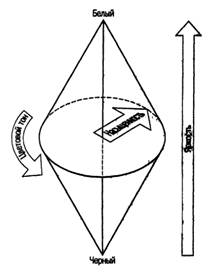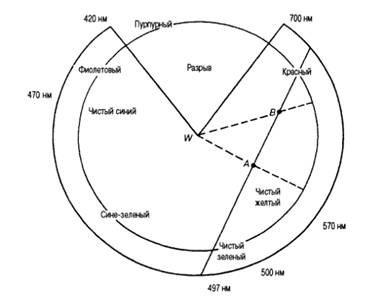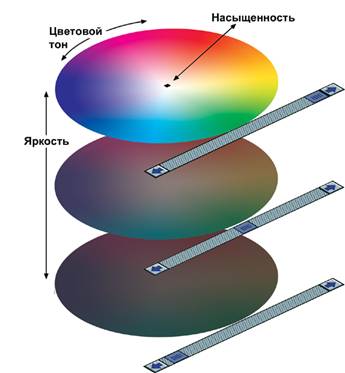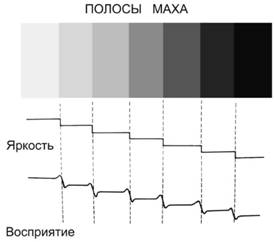Simulation of view. Part two. Perception
1 Excursion in the eye - 2 Perception - 3 Geometry of view - 4 Eye tracking - 5 How to catch the eye - 6 Simulation of eye tracking
This post describes some of the features of human perception occurring at the level of the retina of the eye (before analyzing the picture in the brain). Bold highlights moments directly related to the topic of posts. If some terms are not clear - see the first part .
The main color parameters are hue, brightness and saturation corresponding to a complex of physical parameters of reflected light: wavelength, intensity and spectral purity.
Brightness. The higher the intensity, the brighter the color appears. However, at the same intensity, some colors appear brighter (for example, yellow versus blue). This is due to the distribution of the number of cones of a different type and the types of colors they perceived (for example, yellow is perceived by two types of cones at once, which is much more intense than blue).
')
The spectrally pure monochromatic light is as saturated as possible, however, if you add light with a different wavelength or white to the monochromatic light, the color will be perceived as less pure, on the other hand - brighter.
The three-dimensional color spindle diagram illustrates the connection between color tone, brightness and saturation (illustration from Harvey Schiffman's book “Sensations and Perception”):

The spindle axis represents all shades of gray, the perceived sensation of saturation is shown by the disc and increases from its center to the edges.
The diagram clearly shows that saturation is maximal only at medium brightness levels, with an increase or decrease in brightness the saturation feeling drops.
Newton's color wheel corresponds to the central disk of the spindle at the level of maximum color saturation. Colors are arranged in a color circle so as to emphasize some patterns in the perception of colors.
Each color has its own complimentary color, which occupies a diametrically opposite position in the color wheel. A mixture of complementary colors, taken in a certain ratio, forms a white or gray color. Pairs of complementary colors are antagonistic colors, because they cancel each other's influence on the visual system.
Examples of complementary colors: blue and yellow, red and blue-green, green and purple, and purple lies outside the color wheel, because it does not have its own color wave, but is a sensation arising from the mixing of spectral-pure colors.


Colors that cause the same sensation, but having a different physical nature are called metamers. An example of metamers is spectral green, obtained by decomposing white light through a prism and green, obtained by mixing yellow and blue dye. Colors are additive and substructive. It’s good about how colors are compiled here , and since the color model doesn’t quite fit into the framework of talking about the perception of a picture, it’s enough about the color. This fully explains the perception of a group of pixels on the monitor with a human eye.
As a result of many experiments conducted, it was concluded that a person perceives a change in color and illumination exclusively at the borders. For example, the Mach illusion:

It seems that the edges of the rectangles are underlined. Moreover, it seems that the left borders of the rectangles are lighter than the right ones, although in fact they are evenly colored. Swathes show that even at the level of the retina, contrasting borders are emphasized and perceived more strongly. Or here's the illusion of bright contrast:

The inner squares are identical in brightness, but perceived differently because of the background. The same applies to color perception:

The color appears brighter surrounded by a complimentary background.
Thus, even before analyzing visual information and pattern recognition, the impression of the external world from the eye to the brain is already transmitted in the form of a set of different contours, color and brightness information about various regions .
The border is perceived by the retina as a change in some parameter (brightness, tone, length or direction). In order to feel the border of the retina, it is necessary that the difference in intensity exceeds a certain threshold value.
In the course of the experiments, it was found that for the perception of signals, the dependence called Weber's law is valid : “In order for two signals to be distinguished from each other, the difference between them must be proportional to their absolute value”
 where I is the intensity of perception
where I is the intensity of perception
In the course of the same experiments, it was found that the coefficient k in this formula is approximately 1/60. What does this mean for computer color? Gradations of brightness in the RGB color model correspond to 256 values from 0 to 255. Thus, if you place a lighter square on a black background (0 brightness in the RGB model) and the eye could confidently fix the border of this square, the brightness of the square should be at least 5.
And what about gradients? How is perceived smoothness increase the brightness? For the perception of smoothness, another dependency, called the Fechner law , is important:
 where S is the difference between the change in sensation, and I is the real change in the signal (for example, illumination).
where S is the difference between the change in sensation, and I is the real change in the signal (for example, illumination).
Accordingly, in order to increase the signal felt smoothly I must change exponentially. The coefficient k in this equation is the same coefficient as in the Weber law.
The following relationship, called Stevens’s power law , says how strongly a change in a signal is perceived. For example, how much the difference in brightness or “length” of a line is perceived:

in this equation, the coefficient k is no longer related to the Weber constant and depends on the choice of the metric scale, and the coefficient b is a calculated constant depending on the type of action.
For brightness in the dark, b was experimentally calculated as 0.33, for perception of length — 1.0. Thus, in the case of perception of length, the dependence takes the form:

those. the power of perception of length is directly proportional to the length and the line of 2 centimeters seems to be twice the length of the line of 1 cm.
1 Excursion in the eye - 2 Perception - 3 Geometry of view - 4 Eye tracking - 5 How to catch the eye - 6 Simulation of eye tracking
This post describes some of the features of human perception occurring at the level of the retina of the eye (before analyzing the picture in the brain). Bold highlights moments directly related to the topic of posts. If some terms are not clear - see the first part .
Features of color perception
The main color parameters are hue, brightness and saturation corresponding to a complex of physical parameters of reflected light: wavelength, intensity and spectral purity.
Brightness. The higher the intensity, the brighter the color appears. However, at the same intensity, some colors appear brighter (for example, yellow versus blue). This is due to the distribution of the number of cones of a different type and the types of colors they perceived (for example, yellow is perceived by two types of cones at once, which is much more intense than blue).
')
The spectrally pure monochromatic light is as saturated as possible, however, if you add light with a different wavelength or white to the monochromatic light, the color will be perceived as less pure, on the other hand - brighter.
The three-dimensional color spindle diagram illustrates the connection between color tone, brightness and saturation (illustration from Harvey Schiffman's book “Sensations and Perception”):

The spindle axis represents all shades of gray, the perceived sensation of saturation is shown by the disc and increases from its center to the edges.
The diagram clearly shows that saturation is maximal only at medium brightness levels, with an increase or decrease in brightness the saturation feeling drops.
Newton's color wheel corresponds to the central disk of the spindle at the level of maximum color saturation. Colors are arranged in a color circle so as to emphasize some patterns in the perception of colors.
Each color has its own complimentary color, which occupies a diametrically opposite position in the color wheel. A mixture of complementary colors, taken in a certain ratio, forms a white or gray color. Pairs of complementary colors are antagonistic colors, because they cancel each other's influence on the visual system.
Examples of complementary colors: blue and yellow, red and blue-green, green and purple, and purple lies outside the color wheel, because it does not have its own color wave, but is a sensation arising from the mixing of spectral-pure colors.


Colors that cause the same sensation, but having a different physical nature are called metamers. An example of metamers is spectral green, obtained by decomposing white light through a prism and green, obtained by mixing yellow and blue dye. Colors are additive and substructive. It’s good about how colors are compiled here , and since the color model doesn’t quite fit into the framework of talking about the perception of a picture, it’s enough about the color. This fully explains the perception of a group of pixels on the monitor with a human eye.
Features of the retina
As a result of many experiments conducted, it was concluded that a person perceives a change in color and illumination exclusively at the borders. For example, the Mach illusion:

It seems that the edges of the rectangles are underlined. Moreover, it seems that the left borders of the rectangles are lighter than the right ones, although in fact they are evenly colored. Swathes show that even at the level of the retina, contrasting borders are emphasized and perceived more strongly. Or here's the illusion of bright contrast:

The inner squares are identical in brightness, but perceived differently because of the background. The same applies to color perception:

The color appears brighter surrounded by a complimentary background.
Thus, even before analyzing visual information and pattern recognition, the impression of the external world from the eye to the brain is already transmitted in the form of a set of different contours, color and brightness information about various regions .
Borders and their distinction
The border is perceived by the retina as a change in some parameter (brightness, tone, length or direction). In order to feel the border of the retina, it is necessary that the difference in intensity exceeds a certain threshold value.
In the course of the experiments, it was found that for the perception of signals, the dependence called Weber's law is valid : “In order for two signals to be distinguished from each other, the difference between them must be proportional to their absolute value”
 where I is the intensity of perception
where I is the intensity of perceptionIn the course of the same experiments, it was found that the coefficient k in this formula is approximately 1/60. What does this mean for computer color? Gradations of brightness in the RGB color model correspond to 256 values from 0 to 255. Thus, if you place a lighter square on a black background (0 brightness in the RGB model) and the eye could confidently fix the border of this square, the brightness of the square should be at least 5.
And what about gradients? How is perceived smoothness increase the brightness? For the perception of smoothness, another dependency, called the Fechner law , is important:
 where S is the difference between the change in sensation, and I is the real change in the signal (for example, illumination).
where S is the difference between the change in sensation, and I is the real change in the signal (for example, illumination).Accordingly, in order to increase the signal felt smoothly I must change exponentially. The coefficient k in this equation is the same coefficient as in the Weber law.
The following relationship, called Stevens’s power law , says how strongly a change in a signal is perceived. For example, how much the difference in brightness or “length” of a line is perceived:

in this equation, the coefficient k is no longer related to the Weber constant and depends on the choice of the metric scale, and the coefficient b is a calculated constant depending on the type of action.
For brightness in the dark, b was experimentally calculated as 0.33, for perception of length — 1.0. Thus, in the case of perception of length, the dependence takes the form:

those. the power of perception of length is directly proportional to the length and the line of 2 centimeters seems to be twice the length of the line of 1 cm.
1 Excursion in the eye - 2 Perception - 3 Geometry of view - 4 Eye tracking - 5 How to catch the eye - 6 Simulation of eye tracking
Source: https://habr.com/ru/post/57681/
All Articles